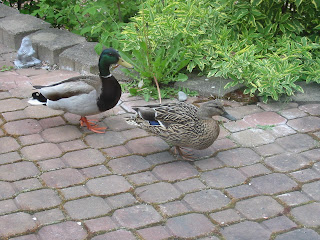Shoreline’s 1st Annual “Where Our Wild Things Are” habitat tour encourages us to garden for wildlife
Wednesday, June 9, 2010
by Jennifer Rotermund
Shoreline’s 1st Annual “Where Our Wild Things Are” Habitat Tour will be Saturday, July 10 from 10 am - 4 pm. There will be mini-learning experiences at each of the seven habitats on the tour, which are designed to demonstrate how easy and fun it is to create a beautiful sanctuary for wildlife in your own yard.
The tour is free of charge, open to the public and begins at Calvin Presbyterian Church, 18826 3rd Ave NW, Shoreline 98177, where maps and directions for the tour will be available. For more information, visit WOWTA’s website or search WOWTA on Facebook.
Gardening for wildlife is fun and easy. In fact, if you’ve always referred to yourself as “a lazy gardener,” you’re most likely already “a wildlife gardener” – tell your friends and family; they’ll think you’re savvy.
Here are a few tips for getting started on your adventures in wildlife gardening:
Leave the aphids on your plants alone. Ok, ok, I know aphids damage leaves and make them look a little unsightly, but did you know aphid populations typically boom right when small birds (like chickadees) hatch their young and aphids make the perfect sized meal for those new little hatchlings?
Don’t cut down old flower stalks. Do you love your perennial flowers, but hate having to cut down the dead flower heads and stalks after they’re done blooming? Every thoughtful wildlife gardener knows that those flowers go on to make seeds, and those seeds help provide a nutritionally varied and healthy diet for local wildlife.
Don’t rake up leaves (or just rake them off your lawn into your garden beds). Leaves – especially those from deciduous shrubs and trees - make wonderful, natural mulch for your garden beds and provide invaluable habitat and food for some of our garden’s most precious wildlife – earthworms, spiders, and the many billions of beneficial micro-organisms. If you don’t have leaves falling in your yard, look for an all-natural or organic mulch at your local nursery or topsoil supply company.
Say good bye to costly chemical fertilizers and pesticides. Most of the time, we really don’t need to buy these products. A garden tended in a natural way is healthier and often self-correcting. Besides, the chemicals in these products can be quite harmful to our wildlife and waterways.
 Go native. Use native plants in your landscape wherever possible. Native plants are low maintenance, look great in the garden because they’re best suited for our region, and provide essential food and habitat for wildlife such as bees, butterflies and hummingbirds.
Go native. Use native plants in your landscape wherever possible. Native plants are low maintenance, look great in the garden because they’re best suited for our region, and provide essential food and habitat for wildlife such as bees, butterflies and hummingbirds.
And attend the Where Our Wild Things Are tour to get some great ideas for your own backyard.
Jennifer Rotermund is the Lead Gardener for Garden of Weedin’ (a local pesticide-free garden maintenance company), owner of Gaiaceous Gardens (an urban vegetable and herb farm and certified wildlife habitat in Shoreline) and Habitat Steward.
Photos by Jennifer Rotermund






0 comments:
Post a Comment